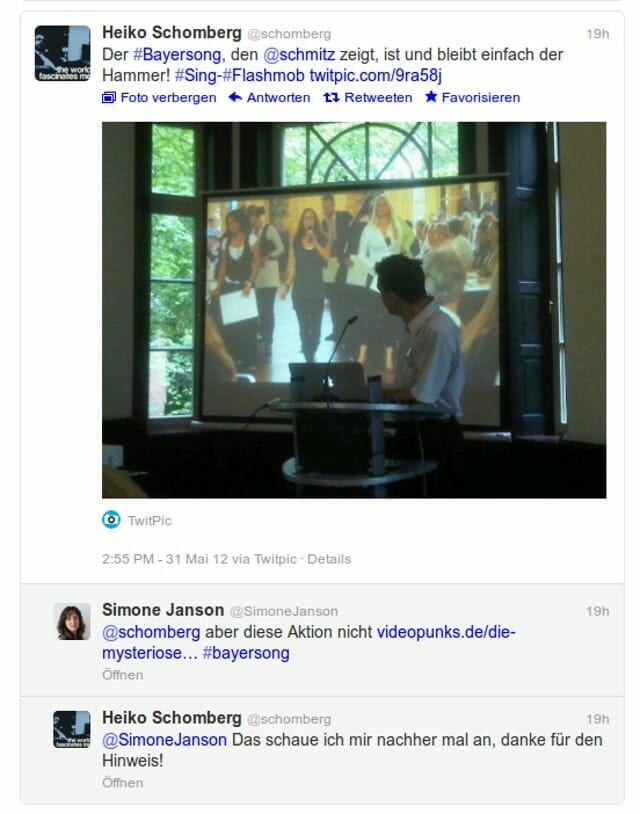For their successful, good life Information you really need: Government-funded publisher, awarded the Global Business Award as Publisher of the Year: Books, Shops, eCourses, data-driven AI-Services. Print and online publications as well as the latest technology go hand in hand - with over 20 years of experience, partners like this Federal Ministry of Education, customers like Samsung, DELL, Telekom or universities. behind it Simone Janson, German Top 10 blogger, referenced in ARD, FAZ, ZEIT, WELT, Wikipedia.
Disclosure & Copyrights: Image material created as part of a free collaboration with Shutterstock. Text originally from: ““How to recognize every lie. Understanding signs, seeing through deception, determining the truth” (2011), published by Münchener Verlagsgruppe (MVG), reprinted with the kind permission of the publisher.
Lies in digital communication: Recognizing the truth in 3 steps
By Pamela Meyer (More) • Last updated on October 03.11.2022, XNUMX • First published on 22.07.2020/XNUMX/XNUMX • So far 7190 readers, 1805 social media shares Likes & Reviews (5 / 5) • Read & write comments
The Internet has our Communication radically changed - and there are liars and cheaters light made. How can this Problem solve?

Modern communication or a brief history of loss of trust
In the past, communication was mostly face-to-face. Relationships were based on regularly interacting face-to-face with one another. This is one reason 80 percent of human communication is non-verbal; the majority of them (65 percent) will do so body language conveyed. Even the whites of our eyes evolved further than other mammals, making it easier for us to communicate without constantly using the Head having to turn. At times when the personal Conversation was still the only form of communication, dozens of subtle cues were available to help us assess our counterpart's trustworthiness. But when we started using modern Technology Communicating across distances became innate Methodsuseless in interpreting nonverbal cues that our ancestors had relied on for millennia.
The telephone, for example, made it possible for people living far away from each other People, with each other in Contact to kick, but at the same time it excluded the possibility of looking at each other during the conversation. Certain signals that can be consciously or unconsciously perceived in direct communication were therefore no longer relevant. All that was left were the words themselves. Even the intonation was sometimes distorted by poor reception. The result? A form of communication over which both partners have less control. Sure one Mothercalling her daughter during term may notice that she's just pretending to be studying (while the typing sound is a telltale sign that she's typing emails instead). But let's say you're discussing an important order form, which contains pages and pages of fine print terms and conditions, with a sales representative you've never met: both parties really get along for sure be that of each other Honestly is to him?
How to unmask liars online
Jeff Hancock, assistantprofessor in Communications at Cornell University, and two of his colleagues conducted a study in which 66 volunteers were paired up and asked to send chat messages to each other. One partner per pair should each address a predetermined set of topics lügen. The "liars" had five minutes to prepare before the test started. The results, published in 2004, are a revelation to anyone who communicates online - which, of course, almost everyone is doing these days. Hancock and his co-authors found that the 33 liars were more communicative than their partners and used about a third more words than those who were honest. They also used more pronouns and more sense verbs like "see," "hear," and "feel«. Hancock surmises that the communicativeness was induced by an effort to tell a more expansive, and therefore more compelling, story. The liars remained undetected in this experiment. But Hancock's findings show that people who are lied to online are more likely to do so Ask than is the case with sincere correspondence. “Although subjects were unaware of the fact that they were being told lies, the data indicate that they must have been implicitly aware that they were being lied to.
"Let's set up a video conference... No, I'll email you... Stop! I think I'd rather call.” The telephone can nevertheless be a useful tool for reading between the lines of what is being said. Linguistic characteristics such as pitch, volume and speed of speech make up almost 12 percent of our communication. You can talk to someone by phone negotiate and read hesitation in a pause, frustration in a sigh, and nervousness in a short laugh. But how often do we use the phone these days? Isn't it easier to contact someone with a quick email? Not always. Paradoxically, the traceability of email makes it unsuitable for the transmission of important or confidential information. "I'd better give you a call," we say whenever there's something to discuss that shouldn't exist in written form. Fewer face-to-face conversations, fewer phone calls – in the end, all we have are words. And believe it or not, the words themselves make up only 7 percent of human communication. We use language every day, we choose it wisely when we can, and yet the words only convey a small fraction of what we are actually communicating.
New media: how secure is the information?
Although human voices cannot be heard through our modern communication channels, they still convey a lot of data. The new media have become silent - but not without a statement. The computing power of PCs doubles within 18 months, Companys expand enormously fast, the data garbage is constantly increasing. The Internet and other communication technologies provide us with more information than we can ever use. 210 billion e-mails are sent every day alone, which corresponds to the amount of letter mail sent in a year.
Three million images - enough to fill a 375.000-page photo album - are uploaded to flickr.com every day. Bloggers post 900.000 new ones Article per day.24 Countless people, organizations and regions contribute to this enormous information overload – some well-known, some relatively unknown, others completely anonymous. It has become an arduous task too decidewhich sources are worth paying attention to. We can no longer rely on a handful of national newspapers, TV and radio stations to determine the relevance of news as we used to.
Video conferencing with no future. Why?
Video conferencing allows employees to have long-distance conversations where they can see each other. While this saves a lot of time and travel expenses, the likelihood is that this practice will become a professional one Everyday life will be rather low. Although Skype and other companies offer free conferencing, most have it Industries don't rush to take advantage of it. In the business environment act Video conferencing is daunting and unnatural - while it may be acceptable to use Skype to communicate with a friend or family member, it's not the medium for business meetings. The reason is that there is no direct eye contact in video conferences - although you can see your conversation partner. Most video conferences are also recorded and archived, making them unusable for sensitive content. Jim Van Meggelen, President and CTO of Core Telecom Innovations, explains this phenomenon as follows:
»The focus of the screen does not correspond to the focus of the camera, so it is impossible to look directly at the interlocutor and look at him at the same time. Either you look at the screen or at the camera. This makes for a very idiosyncratic conversation, because when you look at the screen, the camera records you looking down and not in the direction of the other person. On the other hand, if you face the camera, the person you are talking to will think you are looking straight at them, but you won't be able to actually look them in the face because your eyes aren't on the screen. People value communication, but so do yours Privacy. "
Fake news - which news is actually correct?
A rumor in a blog in the Welt is set, or the unconventional Opinions The message of a political reporter can be relayed to so many Internet users in a short space of time that within a few minutes thousands of people have accepted it as irrefutable fact. In the United States, for example, there was a persistent rumor that during the terrorist attack on the World Trade Center, office workers "surfed along" the outside of the Twin Towers to escape. Who puts the mass of additional information and half-truths online? The anonymity of many bloggers seems to give more power to their words. We don't know them, but it's hard not to pay attention to them.
What if we ignored her and your messages turned out to be correct? So weren't we in danger of missing the next important insider tip or trend? We are concerned that our competitors may be listening to a 24-year-old Twitter expert who claims to know important information about the next emerging market and believe that ignoring it is too risky. So we click from one "cutting-edge" website to the next until we become more and more dependent on the advice and information that people give that we will never meet and who have received advice and information from people they have never met before .
Exposing online lies in 3 steps
We have to judge for ourselves which one Background useful and reliable, and the results have been mixed at best. After all, it's a lot easier to go online and browse the web than it is to wade through the New York Times. Why not read the summary of a news item rather than wasting time researching the sources - especially when the Online-author can reproduce the information in a more amusing and pointed way than the rather brittle written daily newspaper? We rely more and more on secondary information and hearsay.
1. The old tools and why they don't help
The military and intelligence agencies have funded research into human deception for decades. The first and best-known technical aid that was developed for this purpose was the polygraph or the so-called lie detector. This machine has existed in various variants since the early 20th century. This invention is usually credited to William Moulton Marston, creator of the comic book character Wonder Woman. (You may recall that Wonder Woman used to trap villains with her golden lasso, which forced everyone to tell the truth.) The polygraph today simultaneously measures a person's heart rate, blood pressure, respiratory rate, and perspiration while they are being questioned - the underlying theory is that any registered physiological response is presumably due to Stress is due to what one is exposed to when one lies.
Unfortunately, this theory has proven to be quite unreliable. Polygraph tests are rarely allowed in court, although government agencies continue to use them and Developer continue at the Technology file. A further developed device, but not anymore in legal matters Trust is the so-called electroencephalogram (EEG), which is used to measure the electrical activity in the Brain to eat. The theory on which the EEG is based is that if someone tries to make up a plausible story during an interrogation, a clear exhibits higher neural activity than someone who speaks the truth. After all, the honest man has a simple task to accomplish: to remember an event and to relate it.
2. The new tools
On the other hand, a person who has the intent to deceive must first make up a story. Your brain will therefore probably be much more active. Experts are also looking at the thermal scanner, a heat-sensitive camera that measures elevated temperatures. According to some scientists, due to increased blood flow, this is around Eye to tell when someone is lying. Researchers are also testing infrared brain scans, eye trackers, and even a specialized magnetic resonance imaging (MRI) scan for their potential to read the electrical and cognitive signals our bodies send out when we try to fool others.
Maybe one day these technologies will come in handy for the general population, maybe not. But even if this were the case, who would go to work with an EEG device every day? Fortunately, you don't have to take such drastic measures to know whether you can trust your colleagues, business partners or consultants. The best means to track down lies are already available. You just have to learn to use them properly: your ability to interpret. You can learn how to hear what is not said and how to decipher what is said. You can learn to pay attention to voice modulation and pitch and to correctly interpret body language and facial expressions. So it is quite possible to become a human lie detector.
3. The manuscript analysis
A study in the journal Applied Cognitive Psychology suggests that graphology could one day identify truth and lie as reliably as lie detectors. Dr. Gil Luria and Dr. Sara Rosenblum, researcher at Haifa University in Israel, volunteers asked to write two paragraphs, one on truthful things, the other on rhymes. The test subjects used wireless electronic pens with pressure-sensitive tips. For each paragraph, the researchers measured how hard the volunteers pressed the pen, comparing the length of the lines, the height and width of the letters, and the amount of time it took to lift the pen from the digital tablet.
There were clear and consistent differences in writing the honest and dishonest paragraphs. The subjects pressed harder when they lied. The linework of the handwritten script - the height and length of the letters - was also significantly different. The Haifa researchers theorize that the difference is caused by the cognitive stress we feel when we put lies down on paper. We seem to have a hard time writing freely if we don't stick to the truth. "A lie detector that analyzes handwriting has many advantages over existing devices," explained Luria and Rosenblum. “It represents a less uncomfortable situation for the person being examined, it is more objective and independent of human judgement. The System also provides magnitudes that are difficult for the person to control while active.'30 Perhaps this is a good excuse to forgo future thank-you notes for gifts you don't know what to do with.
Here writes for you
Pamela Meyer is a certified fraud investigator and entrepreneur. Pamela Meyer is the founder of Simpatico Networks, one of the leading companies operating online social networks. She holds an MBA from Harvard and is a certified fraud expert. She is comprehensively trained in interview and questioning techniques, the interpretation of microexpressions of the face and body language as well as the analysis of statements and behavior. For the book “How to Recognize Every Lie”, she worked with a research team for several years and put together a comprehensive study of lies and fraud. Meyer is described by Reader's Digest as "the nation's best known expert on lies". All texts by Pamela Meyer.









Post a Comment